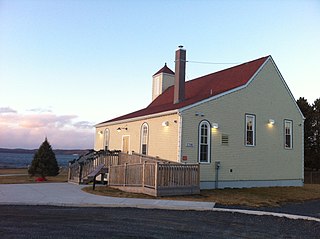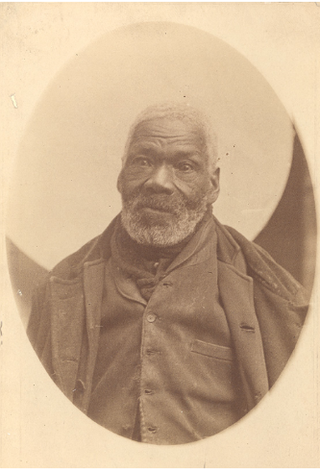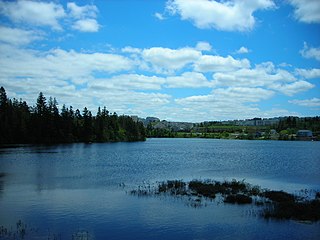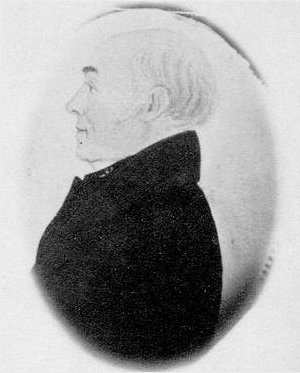
Africville was a small community of predominantly African Nova Scotians located in Halifax, Nova Scotia, Canada. It developed on the southern shore of Bedford Basin and existed from the early 1800s to the 1960s. From 1970 to the present, a protest has occupied space on the grounds. The government has recognized it as a commemorative site and established a museum here. The community has become an important symbol of Black Canadian identity, as an example of the "urban renewal" trend of the 1960s that razed similarly racialized neighbourhoods across Canada, and the struggle against racism.

The Halifax and South Western Railway was a historic Canadian railway operating in the province of Nova Scotia.
East Preston is an expansive rural Black Nova Scotian community located in eastern Halifax Regional Municipality, Nova Scotia, in Atlantic Canada. The population at the time of the 2016 census was 869.
Highway 103 is an east-west highway in Nova Scotia that runs from Halifax to Yarmouth.
Timberlea is a community located within the Municipality of Halifax in Nova Scotia, Canada.
Goffs is a Canadian rural community in Nova Scotia's Halifax Regional Municipality.

Black Nova Scotians are an ethnic group consisting of Black Canadians whose ancestors primarily date back to the Colonial United States as slaves or freemen, later arriving in Nova Scotia, Canada, during the 18th and early 19th centuries. As of the 2021 Census of Canada, 28,220 Black people live in Nova Scotia, most in Halifax. Since the 1950s, numerous Black Nova Scotians have migrated to Toronto for its larger range of opportunities. The first recorded free African person in Nova Scotia, Mathieu da Costa, a Mikmaq interpreter, was recorded among the founders of Port Royal in 1604. West Africans escaped slavery by coming to Nova Scotia in early British and French Colonies in the 17th and 18th centuries. Many came as enslaved people, primarily from the French West Indies to Nova Scotia during the founding of Louisbourg. The second major migration of people to Nova Scotia happened following the American Revolution, when the British evacuated thousands of slaves who had fled to their lines during the war. They were given freedom by the Crown if they joined British lines, and some 3,000 African Americans were resettled in Nova Scotia after the war, where they were known as Black Loyalists. There was also the forced migration of the Jamaican Maroons in 1796, although the British supported the desire of a third of the Loyalists and nearly all of the Maroons to establish Freetown in Sierra Leone four years later, where they formed the Sierra Leone Creole ethnic identity.

Richard Preston,, was a religious leader and abolitionist. He escaped slavery in Virginia to become an important leader for the African Nova Scotian community and in the international struggle against slavery. He established the Cornwallis Street Baptist Church, the African Abolition Society and the African Baptist Association.

Black refugees were black people who escaped slavery in the United States during the War of 1812 and settled in Nova Scotia, New Brunswick, and Trinidad. The term is used in Canada for those who settled in Nova Scotia and New Brunswick. They were the most numerous of the African Americans who sought freedom during the War of 1812. The Black refugees were the second group of African Americans, after the Black Loyalists, to flee American enslavement in wartime and settle in Canada. They make up the most significant single immigration source for today's African Nova Scotian communities. During the antebellum period, however, an estimated 10,000 to 30,000 Black refugees reached freedom in Canada, often traveling alone or in small family groups.
Lakeside is a community within the urban area of the Municipality of Halifax in Nova Scotia.

Lovett Lake is a lake in the community of Beechville in the Halifax Regional Municipality, Nova Scotia, Canada. It is located west of the Halifax Peninsula and the crossing of highways 102 and 103 and directly north of St. Margaret's Bay Road. Now the Beechville Lakeville Timberlea (BLT) trail starts directly north-west of the Lake, on the former main route of the historic Halifax and Southwestern Railway, which was near the lake's north shore.
Upper Hammonds Plains is a Canadian suburban community located in Nova Scotia's Halifax Regional Municipality.

The following outline is provided as an overview of and topical guide to Nova Scotia:

New Horizons Baptist Church is a Baptist church in Halifax, Nova Scotia that was established by Black Refugees in 1832. When the chapel was completed, black citizens of Halifax were reported to be proud because it was evidence that former slaves could establish their own institutions in Nova Scotia. Under the direction of Richard Preston, the church laid the foundation for social action to address the plight of Black Nova Scotians. It is affiliated with the Canadian Baptists of Atlantic Canada.

John Burton (1760–1838) was a Baptist minister in Nova Scotia and was one of the first to integrate black and white Nova Scotians into the same congregation. David George was the first Baptist minister. In 1811, Burton's church had 33 members, the majority of whom were free blacks from Halifax and the neighbouring settlements of Preston and Hammonds Plains.

William Pearly Oliver worked at the Cornwallis Street Baptist Church for twenty-five years (1937–1962) and was instrumental in developing the four leading organizations to support Black Nova Scotians in the 20th century: Nova Scotia Association for the Advancement of Colored People (1945), the Nova Scotia Human Rights Commission (1967), the Black United Front (1969) and the Black Cultural Centre for Nova Scotia (1983). He was instrumental in supporting the case of Viola Desmond. Oliver was awarded the Order of Canada in 1984.
Paula Anne Gallant was a Canadian school teacher who was murdered by asphyxiation due to strangulation. On December 27, 2005, Gallant and her husband, Jason MacRae were in their basement arguing about a debt from online gambling. After MacRae walked back down to the basement where Gallant was sitting at the computer, he hit her in the back of her head with a two-by-four wood board. He then proceeded to strangle her to the floor until she stopped moving and then wrapped her head with Saran Wrap to make sure she was dead.

The Chain of Lakes Trail is a paved multi-use recreational trail in Halifax, Nova Scotia that runs from Beechville to Fairview. The trail is named for the Chain Lakes along which the trail runs. The trail is part of the Rum Runners trail system, going from Halifax to Lunenburg. They are part of Nova Scotia's Blue Route, a planned 3,000 kilometer cycling trail system.

The Beechville Lakeside Timberlea Trail is a multi-use recreational trail in Halifax, Nova Scotia that runs from Lewis Lake to Beechville. The trail is named for the towns through which it travels, namely Timberlea, Lakeside, and Beechville from west to east. The route is parallel to Trunk 3. The trail is part of the Rum Runners trail system, going from Halifax to Lunenburg, which is part of Nova Scotia's Blue Route cycling network.
Donald D. Skeir was a Canadian pastor, community leader, and educator in the African Nova Scotian community.













